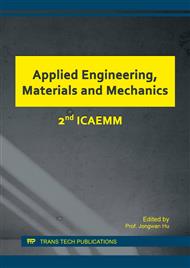[1]
O. Brock and O. Khatib, Elastic strips: A framework for motion generation in human environments, Int, J. Robot. Res. 21(12) (2002) 1031-1052.
DOI: 10.1177/0278364902021012002
Google Scholar
[2]
H. Toshani and M. Farrokhi, Kinematic control of a seven DOF robot manipulator with joint limits and obstacle avoidance using neural networks, The 2nd International Conference on Control, Instrumentation and Automation, Shiraz, 2011, 976-981.
DOI: 10.1109/icciautom.2011.6356794
Google Scholar
[3]
A. Liegeois, Automatic supervisory control of the configuration and behavior of multibody mechanisms, IEEE Trans. Syst. Man. Cybern. SMC-7(12) (1977) 868-871.
DOI: 10.1109/tsmc.1977.4309644
Google Scholar
[4]
M. Benzaoui, H. Chwkireb and M. Tadjine, Redundant robot manipulator control with obstacle avoidance using extended jacobian method, 18th Mediterranean Conference on Control & Automation, Morocco, Marrakech, June 2010, 371-376.
DOI: 10.1109/med.2010.5547696
Google Scholar
[5]
T. Chan, R. Dubey, A weighted least-norm solution based scheme for avoiding joint limits for redundant joint manipulators, IEEE International Conference on Robotics and Automation, 1993, 395-402.
DOI: 10.1109/robot.1993.292205
Google Scholar
[6]
M. Bjerkeng, A. A. Transeth, K. Y. Pettersen, E. Kyrkjebo, S. A. Fjerdingen, Active camera control with obstacle avoidance for remote operations with industrial manipulators: Implementation and experimental results, IEEE/RSJ International Conference on Intelligent Robots and Systems, 2011, 247-254.
DOI: 10.1109/iros.2011.6094823
Google Scholar
[7]
O. Khatib, Real-time obstacle avoidance for manipulators and mobile robots, Int. J. Robot. Res. 5(1) (1986) 90–98.
DOI: 10.1007/978-1-4613-8997-2_29
Google Scholar
[8]
D. Park, H. Hoffmann, P. Pastor, and S. Schaal, Movement reproduction and obstacle avoidance with dynamic movement primitives and potential fields, in Proc. 8th IEEE-RAS Int. Conf. Humanoid Robot. Humanoids, Dec. 2008, 91–98.
DOI: 10.1109/ichr.2008.4755937
Google Scholar
[9]
B. Lacevic, P. Rocco, Kinetostatic danger field-a novel safety assessment for human-robot interaction, IEEE/RSJ International Conference on Intelligent Robots and Systems, 2010, 2169-2174.
DOI: 10.1109/iros.2010.5649124
Google Scholar
[10]
B. Siciliano, L. Sciavicco, L. Villani, G. Oriolo. Robotics: Modelling, Planning and Control, London: Springer-Verlag, 2009, 97-100.
Google Scholar
[11]
H. Das, J. J. Slotine, T.B. Sheridan, Inverse kinematic algorithms for redundant systems, IEEE International Conference on Robotics and Automation, 1988, 43-48.
DOI: 10.1109/robot.1988.12021
Google Scholar
[12]
B. Lacevic, P. Rocco, A. M. Zanchettin, Safety assessment and control of robotic manipulators using danger field, IEEE Trans. Robot. 29(5) (2013) 1257-1270.
DOI: 10.1109/tro.2013.2271097
Google Scholar


